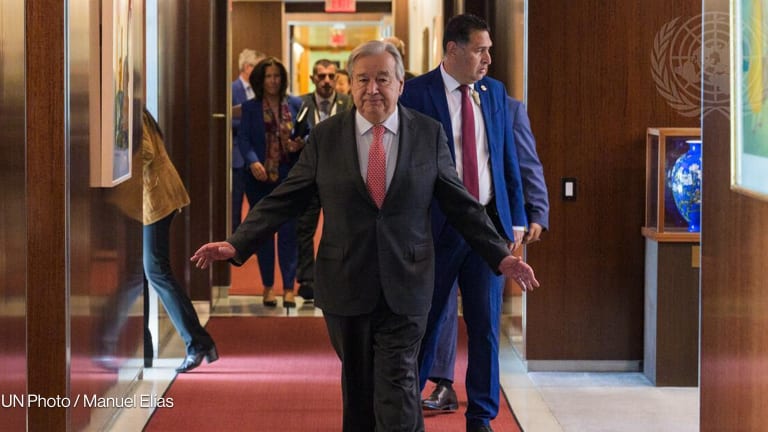
Last week, the United Nations Security Council agreed to recommend António Guterres for a second term as secretary-general. The General Assembly is expected to confirm his reappointment Friday.
Guterres was first appointed in 2016, following the most open selection process in U.N. history with a field of 13 candidates, including seven women. This year, with just one official candidate, the process did not exactly have onlookers reaching for the popcorn. Clearly, the dynamic was changed by the presence of an incumbent, especially one who remains popular with member states. Potential candidates with a good shot at becoming the 10th secretary-general preferred to sit this one out.
Nonetheless, this year’s process was important to consolidate gains and prepare for 2026. While the improvements we secured five years ago — a public list of candidates, vision statements, and dialogues — may seem like the bare minimum, they made a huge difference for a process that was, for 70 years, more secretive than a papal conclave.
The 1 for 7 Billion campaign pushed hard for the General Assembly and Security Council to apply these improvements this time, despite the presence of an incumbent, to provide the opportunity for Guterres to answer questions about his term and for all member states to have the option of presenting other candidates. To date, only one secretary-general seeking reappointment has been denied a second term — almost entirely at the behest of a single powerful state.
The 1 for 7 Billion campaign was able to make headway in 2016 because we began work years before. The road to 2026 starts now.
—We were pleased to see Guterres submit a vision statement and take part in a public dialogue in the General Assembly. Next time, we hope that civil society engagement will not be confined to a couple of questions and that states will work together to make more effective use of these sessions.
However, the process also highlighted the need to address a number of issues ahead of the next appointment, expected to take place in 2026.
This year, a number of individuals sought to nominate themselves for the secretary-general role, and a youth-led initiative called Forward tried to nominate a former head of state — Rosalía Arteaga — who was endorsed by supporters through an online vote. None of these individuals had formal state backing.
While not explicitly called for in GA Resolution 69/321 on the process, letters sent by the presidents of the General Assembly and Security Council in 2015 and 2021 refer to “Member States presenting candidates,” and this was clearly the understanding on which many states were operating.
The resulting confusion put the president of the General Assembly in an awkward position, potentially risking the assembly’s regained authority over the process. It also left individuals who were seeking the role in limbo, generating press coverage.
The 1 for 7 Billion campaign has consistently called for civil society to play an active part in the selection process. After all, the Charter of the United Nations opens with the words “WE THE PEOPLES,” and the secretary-general has the potential to impact the lives of all the world’s people.
But it is precisely because the role is so important that prospective candidates should be asked to do more than just submit a CV. And we should not raise false hopes that the secretary-general can be elected by the world’s people; the U.N. is an organization of member states.
Rather, we should focus on creating the best possible process to produce the best possible person.
The 1 for 7 Billion campaign believes this means three things. First is formalizing the requirement for candidates to be nominated by one or more states. If you can’t convince a single government to back you, it is highly unlikely that you could win the trust of the wider U.N. membership, let alone act as an effective conflict mediator or inspire international action on the climate emergency.
Second is ensuring a diverse field of high-caliber candidates. States should work with civil society to identify candidates from all regions and backgrounds — and bring them into the official process. There are plenty of strong female contenders, as well as qualified individuals who are younger than candidates have been in the past; Igor Lukšić was 39 when he launched his bid in 2016.
And there is plenty of scope for creativity. A state or group of states could agree to nominate a candidate emerging from a civil society search process, for instance.
Why the UN chief race might wrap sooner than expected
While several others have stepped forward to run for the U.N. secretary-general role, only incumbent António Guterres has been formally recognized as a candidate.
Last is revisiting outstanding issues. There is significant state support for a single, nonrenewable term for secretaries-general, which would remove pressures around reappointment campaigning and the Security Council presenting a shortlist of candidates to the General Assembly. These proposals would mean real contests every time.
The 1 for 7 Billion campaign has written to all states, urging them to use this year’s General Assembly “revitalization” resolution to make progress well in advance of the next appointment. We also encourage civil society organizations to work together to design processes that produce an inspiring field of candidates and give all people, including underrepresented and offline communities, a chance to have their say.
This could take many forms, from national search efforts to polling on candidate priorities and public debates that provide space for raising issues unlikely to get an airing in General Assembly dialogues.
The 1 for 7 Billion campaign was able to make headway in 2016 because we began work years before. The road to 2026 starts now.








